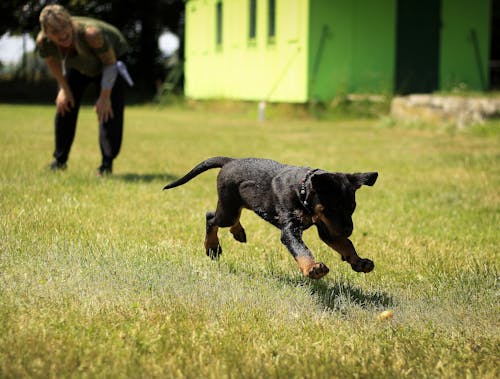Dog training Advice And Support
Puppy training can be quite challenging if you do not know the right techniques and strategies to apply. Also - with all the puppy training advice available on the internet, how can you tell who's worth listening to and who's not? So the question to ask yourself here is - "Is there really a "right" way to obedience train your puppy?"
Fortunately - there is, even better - with the right training advice, tips and techniques, you can make puppy training fun and fast. To ensure success for you and your puppy, you need to first set realistic goals, and then you need to make sure you have the know-how for executing them effectively.
So here are is a list of my best puppy training advice:
Tip 1: Employ positive reinforcement for best results.
This basically means that you train your puppy, by teaching him that every time he does something the right way (pees in his potty spot, comes when called for, sits when you're giving him his food, etc.) he gets rewarded for it - either with a treat, with his favourite toy, or with love and praise.
The way this is different from conventional puppy training techniques is that you reinforce positive behaviors, as opposed to punishing negative ones. That way you're effectively teaching your puppy that you're there to support and love him.
Tip 2: Use the NO command right from the start.
So if you want to curb a negative behavior - just use your most authoritative voice and say NO - but without shouting. Even though your dog does not understand the meaning of NO, the tone of your voice will serve as a warning to him - he'll pretty soon learn that this command means he has to stop the given behavior. Note that your NO voice should always be the same.
Tip 3: Teach your puppy the basic dog commands such as SIT, COME, and NO.
OK, let's be clear on this. At first your puppy will not be very good at following orders - he's too young. So for the time being, start teaching him, but don't expect miracles. All you're doing is setting the foundations.
You can start teaching him the SIT, for e.g, every time you feed him, or every time you wan to give him a treat. The NO command we've already touched on. And to teach him the COME, start by calling him to COME every time he's already on his way to you. So basically you're associating the sound and tone of a word command to an action he's performing - that way he learns what you want from him.
These commands are interconnected; one command is necessary to carry out another. In order not to confuse your dog, concentrate on one command only at a time. Once your dog successfully understands it, you can move on to the next one. It does not matter which command you teach first.
Tip 4: Use a leash.
OK, for this one you'd actually first have to teach your pup to use a leash. Some puppies take to it like ducks to water, some may create a bit of problems. But presuming your puppy would stay on the leash use it while training - it will help you tremendously in keeping him in attention.
If you decide to use a leash - buy a long leash so that your dog can move freely and won't feel restricted. Whenever your dog's attention wanders, tug the leash ever so lightly to bring his attention back to you.
Tip 5: Your puppy's crate can be an indispensable training aid.
Some people think putting your puppy in a crate is cruel - but that's not right. A crate is a great training aid. Use it to help you with feeding time training, with bed time training, potty training, and when leaving your puppy unsupervised in your home.
Dogs love having a routine and a crate gives them exactly that and the security of having their own space. Crate training can be tricky, some dogs will just not want to stay alone, but if done correctly crate training is the silver bullet of my puppy training advice to you.
Tip 6: Does your puppy need obedience training school?
What do you do when you cannot keep your dog under control anymore? Is it necessary to send him off to obedience training lessons? The choice is all yours of course. But my advice to you is to get your puppy trained either way.
If you think training your dog takes too much of your personal time and you just can't get the hang of it, then send him to a good obedience school. Find out what the best in the are is and go for it. The bottom line is that you need to instill rules in your relationship - or later on in life you will end up with behavior problems that may be harder to resolve.
Tip 7: Consider your dog's breed.
If you haven't yet go a puppy - now's the time to learn a little about the different dog breeds and how easy they are to train. Toy breeds can be a bit more work, while hunting ones just need a more specialist approach. The latest trend is for cross breed and designer dogs, because they are more trainable, but some of the bigger dogs are also a good choice - a Labrador Retriever being one of the best examples.
At the end of the day, although puppy training can be frustrating at times, remember to enjoy the whole process. It's the perfect time to bond with your dog and establish a truly loving relationship. Remember to be be consistent in your teachings, confident in your commands, loving and persistent - and things will fall into place. Once you get your puppy's trust, you can count on him to be your loyal friend for a very very long time.
CHECK THE RECOMMENDED DOG TRAINING PROGRAM HERE !
http://EzineArticles.com/3003751



Comments
Post a Comment